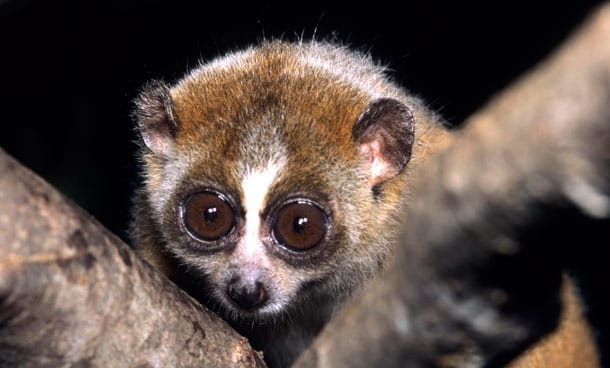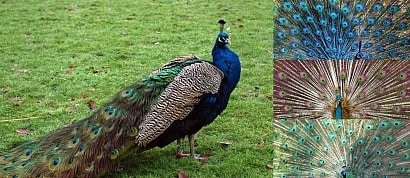Animals With The Most Bizarre Defense Mechanisms..
 Add image to section
Add image to section
Slow Loris

The Slow Loris, as its name suggests, is a painfully slow-moving creature which makes it vulnerable to predators. In order to deal with its lack of speed, the Loris has developed poison glands near its armpits! It coats its body by rubbing its hands on these glands and then it applies the poison on its body and teeth. The resulting bite can put a predator into anaphylactic shock.
 Add image to section
Add image to section
Dormouse

The adorable Dormhouse has a peculiar way of giving predators the slip….literally. The skin in the dormouse’s tail is very loose, and if a predator grabs the critter by the tail, the skin comes off allowing the dormouse to escape. However, the dormouse can only do this once in its lifetime because after the skin is gone, the remaining bone is either gnawed off or left to fall off naturally.
 Add image to section
Add image to section
African crested porcupines

Armed with quills long enough to pierce through predators’ internal organs, the African crested porcupine is one animal you’d be wise to avoid. If it sense danger, the porcupine will charge backwards or sideways to stab the quills into the predator. If it’s being chased, it will stop suddenly, causing the predator to run headlong into its quills.
 Add image to section
Add image to section
Elephant hawk-moth caterpillar
 Add image to section
Add image to section
Pygmy Sperm Whale

Being one of the smallest species of toothed whales in the sperm whale family, the pygmy sperm whales have a developed a grotesque (but effective) defense mechanism. When threatened, the whale will secrete an anal syrup into the water. The whale then stirs up the water to create a giant cloud of poo in which it can take cover in.
 Add image to section
Add image to section
The Northern Fulmar
 Add image to section
Add image to section
The bombardier beetle

If you mess with this beetle, you are going to get a very unpleasant surprise. The bombardier beetle sprays its predators with a hot, noxious spray of toxic bodily fluids, right out of its anus. To do this the beetle stores hydroquinones, hydrogen peroxide, and a mix of enzymes that catalyze an explosive reaction shooting out at almost boiling point.
 Add image to section
Add image to section
The Hairy Frog

What if every time you felt threatened, your first and only method of defense was to break your own bones and use them for weapons? Meet the hairy frog, a Central African species that, despite its name and fuzzy appearance, isn’t hairy at all. When breeding, the male frogs develop thin strands of skin along the sides of their bodies that resemble hair. These strands also, in theory, allow the frogs to take in more oxygen while they watch over their eggs. But what’s really compelling about this frog is its ability to crack its own toe bones and push them through their skin to form sharp claws, great for warding off would-be attackers.
While it’s not completely clear what happens to the bones after the threat of attack subsides, researchers believe the bones slide back under the skin when the frog’s muscles relax.
 Add image to section
Add image to section
Iberian Ribbed Newt

Found on the Iberian Peninsula and Morocco, the Iberian Ribbed Newt has developed an alarming self-defense mechanism. When in danger, the newt will push its ribs through the skin which it uses as weapons. The exposed bones are then covered with a poisonous substance which has the potential to kill its predator.
 Add image to section
Add image to section
Japetella heathi Octopus

The Japetella heathi octopus has developed a defense mechanism which enables it to evade two types of deadly predators—those that look for silhouettes from above, and those which use their own light to find prey. To avoid creating a silhouette, the octopus is almost completely transparent. However, this makes it a target for creatures with bioluminescense. To avoid these, the octopus changes its color to red, greatly reducing its reflectivity. This effectively makes the octopus invisible to angler fish and other headlight fish.
 Add image to section
Add image to section
Turkey Vultures

When the Turkey vulture sense predatory danger, it will regurgitate the entire contents of its stomach; (which is utterly disgusting… and let’s not even talk about the smell). This enables the vulture to run away faster as it’s a lot lighter but more than likely the predator would have been spooked off anyways.
 Add image to section
Add image to section
Boxer Crabs
 Add image to section
Add image to section
The Potato beetle
 Add image to section
Add image to section
The Hagfish
 Add image to section
Add image to section
Flying Fish

The flying fish has developed an extraordinary ability to fly or glide for long distances in order to evade predators. To accomplish this, the fish swims at speeds of up to 37 mph (60 km) enabling it to break through the water surface. Then it uses its large pectoral fins as wings which allow the fish to become airborne. Once out of the water, it can fly for up to 656 feet (200 meters).
 Add image to section
Add image to section
Opossum
 Add image to section
Add image to section
Malaysian exploding ant
 Add image to section
Add image to section
Octopoteuthis deletron

Like most squids, the Octopoteuthis deletron is able to squirt ink as a defense. But what makes this guy so unique is its ability to jettison one of its arms in a process called arm autonomy. This not only minimizes tissue loss from an attack, but also distracts the predator enough for the squid to escape.
 Add image to section
Add image to section
Sea Cucumbers

When threatened, a sea cucumber releases a sticky poisonous toxin called holothurin. And if that doesn’t do it, the sea cucumber will self-eviscerate. Meaning they will violently contract their muscles together until they secrete some of their organs out of their anus. This fools predators into thinking they are already dead.
 Add image to section
Add image to section
The stick insect

As the name implies, the stick insect looks like a stick, but can sometimes even look like leaves with mossy outgrowths. But camouflage is not its only line of defense for these guys; some stick insects can also spray their attackers with a defensive secretion which not only smells bad but can also cause mouth and eye irritation.
Load more items (5 more in this list)
Animals With The Most Bizarre Defense Mechanisms You’ve Ever Seen
There is no end to the amount of crazy and bizarre things you can find in the animal kingdom. Today, we’re taking a look at animals’ defense mechanisms, and not surprising, we have found some pretty bizarre (and sometimes downright nasty) stuff. From animals that will projectile-vomit on your face to creatures that will literally knock you out with their stench, these are 25 animals with the most bizarre defense mechanisms you’ve ever seen.
Added to
19 votes
Favourite Animal Lists
(15 lists)list by shotswerefired
Published 8 years, 3 months ago  3 comments
3 comments
 3 comments
3 commentsPeople who voted for this also voted for
Cigarette Cards: Butterflies & Moths (1938)
Welsh Beauty: Jamie Lee Williams
Marvellous lakes
My Picture's In Listal XVII
My Sweet Bunny, Funny Cartoon , Thank You Gifs
Creative Colorful Photography
Great Gardens: Ninfa, Italy
Edita Sahakyan
Films and Blindness
Favorite Images of Peacocks
Stone Rockd Art By Sharon Cummings Painting
My Mister Photogenic Lists
Remembering Sidney Poitier
national park Malá Fatra,Slovakia
Buildings with Faces
More lists from Milena
Weird Islands That Will Leave You Scratching ...
Adorable Spiders That Are Not As Scary As You...
Reasons Why You Should Consider Owning A Dog
Adorable Hatchlings That Are Too Cute For Their...
Fashion models & styles from the 1930s
Crazy Drunk Animals
Reasons The Animal Kingdom Is More Ridiculous ....
 Login
Login






























